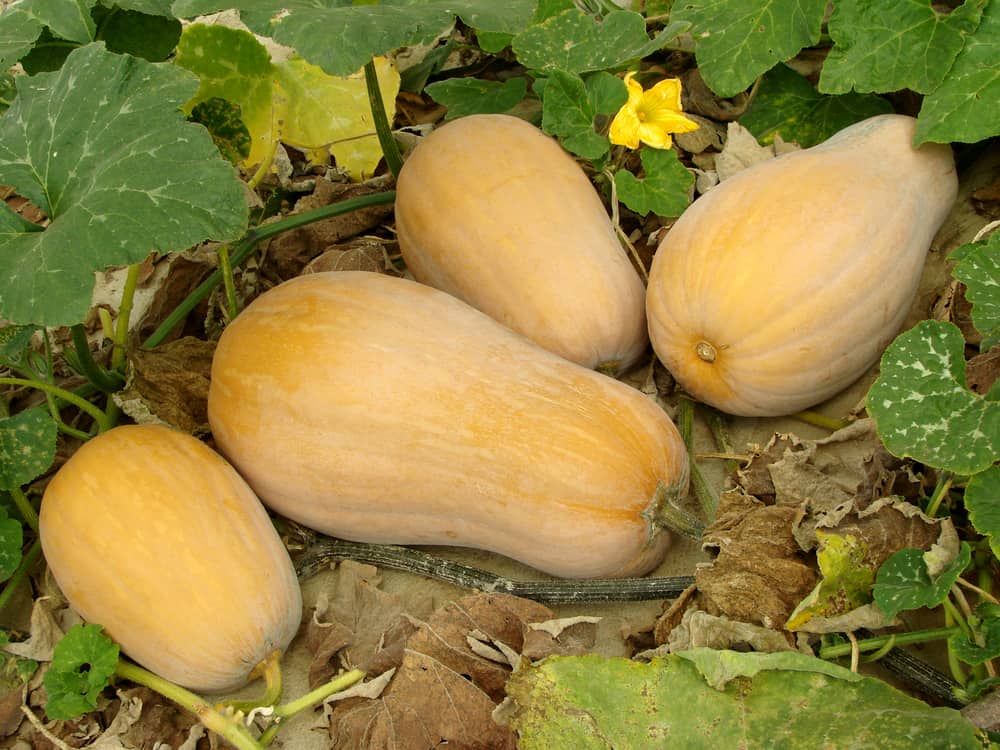Butternut squash is a delicious winter squash that is delicious when eaten by itself, in soups, or salad. Its scientific name is Cucurbita moschata. This article will cover all the growth stages of this delicious and healthy squash. With adequate moisture and warmth, you should have a healthy and delicious plant within 100 days or so.
Germination
In order to grow butternut squash, your garden must have warm soil. Butternut squash seeds cannot survive frost and can only thrive in warm soil. The soil must be at least 60 degrees Fahrenheit. However, the ideal temperature range is between 70 and 95 degrees. This particular temperature range will produce germination within a week. If the soil temperature falls below 60°, you run the risk of slowly germinating seeds, or no germination at all.
While it is important to keep the soil moist for proper germination, it does not mean you should drown your budding plant. If you over water the seeds, you may cause them to rot in the soil. Adding manure or compost to your soil is a great way to hold in moisture. There is no need to water the soil daily - two or three times weekly will suffice.
Ideally, you should plant the seeds three to four feet apart in rows, and the rows should be 8 to 12 feet apart.
Unlike other seeds, you don’t need to soak butternut squash seeds before planting them. Focus more on having moist soil to plant them in. If you are planting fresh seeds, wash them thoroughly to remove any remaining flesh. Lay each seed out on a paper towel until they are dry. Next, store the seeds away from sunlight in a dry area for 3 to 7 days.
The seeds will sprout best in small hills. Each hill should be about 3 inches high with a one inch hole dug at the top. Drop a seed in the hole and cover it with dirt.
Seedling
As mentioned earlier, adding manure or compost helps to moisturize your soil. It is also useful for feeding the butternut squash seeds. The seeds need a lot of feed and should be fertilized about three times throughout the growing season. Make sure the soil does not become dry - water three times a week.
Flowering and Fruiting
The butternut squash seeds will begin to flower in two stages. The first flowers will be male and yellow. These flowers are also edible. If you do not use these flowers, don’t worry, they will fall off within a week. The next group of flowers will be female and must be left on the vine - do not pick those off. You will see the female flowers right above the tiny fruits.
Once the budding fruits begin to swell, fertilize the squash every 10 to 14 days with a liquid squash fertilizer.
The flowering and fruiting stage of the butternut squash plant is a very delicate phase. Do your best to keep pests away from the budding leaves. Normally, pests won’t bother your plants until the butternut squash has completed its growth cycle.
Ripening
A butternut squash reaches maturity within 45 to 55 days after flowering. The fully grown fruit will be green and soft to the touch. As it continues to ripen, the green will fade and a tan color will start to come in.
Remember, if your butternut squash still has green stripes, it is not right yet. A ripe butternut squash will always have a solid tan color. The butternut squash will turn from dark green to this solid tan color within a few weeks.
Once it is fully ripened, not only will it be tan, but your fingernails won’t be able to scratch the skin.The skin should be completely hard at this point. The stem will also be hard, brown, and shrivelled as well.

Harvest
Now that your squash is ripe, you can harvest it and enjoy its delicious taste. Don’t leave them on the vine too long though. You must harvest butternut squash before the first frost sets in order to avoid rotting.
Sharpen a knife and cut the squash from the vines. At least three to four inches of the stem should be intact. Unless you plan to eat all of the squash immediately, you will have to store it properly. As long as you keep your harvested squash in a cool and dry area, they should keep for several months.
As long as you have grown your butternut squash in the spring or summer, they should be ready for harvest by October or November. Try to avoid planting them too late, so they won’t end up ripening during a frost. They will end up freezing on the vine. If you must harvest your squash early because of an early winter, curing techniques can help improve storage.
